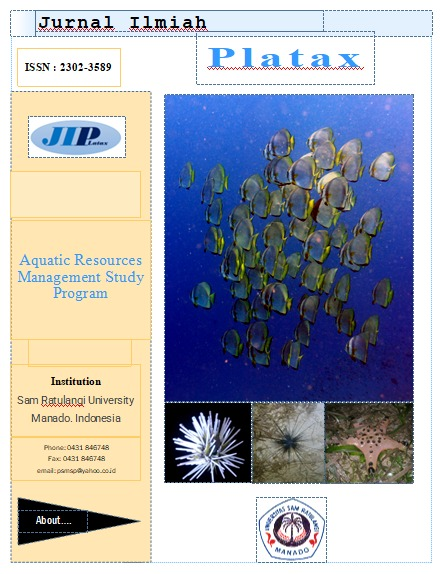Temperature, Salinity and Dissolved Oxygen West and East seasons in the waters of Amurang Bay, North Sulawesi
DOI:
https://doi.org/10.35800/jip.v11i1.46651Keywords:
oceanographic conditions;, temperature;, salinity;, dissolved oxygen;, Amurang Bay;Abstract
Observations of temperature, salinity, and dissolved oxygen have been carried out in Amurang Bay waters, North Sulawesi. This study aims to determine the temperature, salinity, and dissolved oxygen during the west and east seasonal monsoons. The statistical analysis results using the t-test showed that the temperature, salinity, and dissolved oxygen in the West monsoon with the east monsoon were significantly different. Temperature, salinity, and dissolved oxygen in the west monsoon are lower than in the east. Variations in temperature, salinity, and dissolved oxygen are influenced by atmospheric conditions, weather, rainfall, and current patterns. Implicitly, temperature and salinity can affect the solubility of oxygen in the East monsoon. The value of AOU (Apparent Oxygen Utilization) in the west monsoon is less than 0.00 mg/l (negative), which indicates that oxygen is very much needed for the process of respiration and decomposition of organic substances during the west monsoon.
Keywords: oceanographic conditions, temperature, salinity, dissolved oxygen, Amurang Bay.
References
Andriani, E. D. 1999. Kondisi Fisika-Kimiawi Air Perairan Pantai Sekitar Tambak Balai Budidaya Air Payau (BBAP) Jepara, Kabupaten Jepara, Jawa Tengah. Skripsi. Fakultas Perikanan dan Ilmu Kelautan, Institut Pertanian Bogor.
Hadikusumah dan Sugiarto. 2001. Penelitian Sumberdaya Laut di Kawasan Pengelola dan Pengembangan Laut (KAPPEL) Sulawesi Utara. Bidang Oseanografi, Proyek Pengembangan dan Penerapan IPTEK Kelautan. Laporan Akhir. Pusat Penelitian dan Pengembangan Oseanologi. Lembaga llmu Pengetahuan Indonesia. 1-21.
Hamzah, F. dan M. Trenggono. 2014. Oksigen terlarut di Selat Lombok. Jurnal Kelautan Nasional. 9(1):21-35.
Ippen, A.T. 1966. Estuary and Coastline Hydrodynamics. Mc. Graw-Hill Book Company, Inc.: 744 pp.
Kementerian Negara Lingkungan Hidup. 2004. Keputusan Menteri Negara Lingkungan Hidup No. 51 Tahun 2004 Tentang Baku Mutu Air Laut Untuk Biota Laut. Jakarta. 32 hal.
Nontji, A. 2002. Laut Nusantara. Penerbit Djambatan. Jakarta. 59-67.
Nurhayati. 2002. Karakteristik Hidrografi dan Arus di Perairan Selat Malaka. Perairan Indonesia Oseanografi, Biologi dan Lingkungan. Puslit Oseanografi LIPI. Jakarta. 1-8.
Nurhayati. 2006. Distribusi vertikan suhu, salinitas dan arus di perairan Morotai, Maluku Utara. Oseanologi dan Limnologi di Indonesia. 40: 29 - 41.
Nybakken, W.J. 1988. Biologi Laut. Suatu Pendekatan Ekologis. Gramedia, Jakarta. 459 hal.
Romimohtarto, K dan Thayib, S.S. 1982. Kondisi Lingkungan dan Laut di Indonesia. LON-LIPI, Jakarta. 246 hal.
Sapulete, D dan S. Birowo. 1990. Kandungan oksigen di Teluk Ambon. Dalam: “Perairan Maluku dan sekitarnya”. (D. P. Praseno, W. S. Atmaja, I. Supangat, Ruyitno dan B. S. Sudibjo, eds). Balitbang Sumberdaya Laut P3O-LIPI, Ambon. 199-204.
Sidjabat, M.M. 1974. Pengantar Oseanografi. Institut Pertanian Bogor. 238 pp.
Tarigan, M.S. dan Edward. 2000. Perubahan Musiman Suhu, Salinitas, Oksigen Terlarut, Fosfat dan Nitrat di Perairan Teluk Ambon. Pesisir dan Pantai Indonesia IV. Puslitbang Oseanologi-LIPI, Jakarta. 77 hal.
Officer, C.B. 1976. Physical Oceanography of Estuaries and Associated Coastal Waters. John Willey and Sons. New York. 465 pp.
Downloads
Published
How to Cite
Issue
Section
License
Copyright (c) 2023 SIMON I. PATTY, RIKARDO HUWAE

This work is licensed under a Creative Commons Attribution-NonCommercial 4.0 International License.
COPYRIGHT
Authors who publish with this journal agree to the following terms:
Authors hold their copyright and grant this journal the privilege of first publication, with the work simultaneously licensed under a Creative Commons Attribution License that permits others to impart the work with an acknowledgment of the work's origin and initial publication by this journal.
Authors can enter into separate or additional contractual arrangements for the non-exclusive distribution of the journal's published version of the work (for example, post it to an institutional repository or publish it in a book), with an acknowledgment of its underlying publication in this journal.
Authors are permitted and encouraged to post their work online (for example, in institutional repositories or on their website) as it can lead to productive exchanges, as well as earlier and greater citation of the published work (See The Effect of Open Access).




















